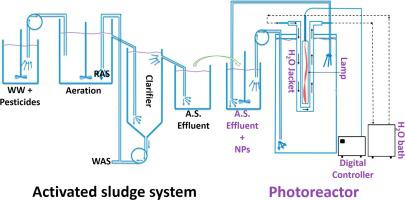Journal of Water Process Engineering ( IF 6.3 ) Pub Date : 2021-01-15 , DOI: 10.1016/j.jwpe.2021.101918 Lwazi Charles Mahlalela , Cintia Casado , Javier Marugán , Santiago Septien , Thabile Ndlovu , Langelihle Nsikayezwe Dlamini

|
Pollutants, such as pesticides, find their way into wastewater treatment plants (WWTPs). WWTPs have been reported to be unable to fully remove these pesticides from water. Hence, research has been conducted in the development of methods to degrade them in wastewater. This work reports the coupling of biological and photocatalytic processes to particularly treat two model pesticides (atrazine and tebuthiuron) in aqueous solution. Liquid chromatography-mass spectroscopy/mass spectroscopy (LC-MS/MS) was used as an advanced analytical technique for the identification of both atrazine and tebuthiuron, and their degradation by products. The LCMS/MS data showed that atrazine and tebuthiuron were only removed substantially during their first treatment days. Based on LCMS/MS results, biodegradation of atrazine in the biological treatment section was via dealkylation to yield deethylatrazine (m/z 198), (2) dechlorination to yield N-isopropylammelide (m/z 156), and (3) deamination to yield cyanuric acid (m/z 129). There were no identified metabolites of tebuthiuron which suggested its structural stability, but a decrease was observed at the beginning of the treatment of the pollutant probably due to adsorption on the sludge. Photocatalysis further reduced the concentration of atrazine, while there was no significant decrease in tebuthiuron. The atrazine degradation pathways that were identified during photocatalysis studies were (1) degradation of atrazine (CIET, m/z 216) through the formation of hydroxyatrazine (OEIT, m/z 197), desethylhydroxyatrazine (OIAT, m/z 155), ammeline (OAAT, m/z 127) and cyanuric acid (OOOT, m/z 129), and (2) the degradation of atrazine, after the formation hydroxyatrazine (OEIT, m/z 197), could also proceed to form deethylatrazine (CIAA, m/z 198), followed by the formation of N-isopropylammelide (IAT, 156) and finally cyanuric acid (OOOT, m/z 129). The bio-photodegradation treatment process was efficient for the removal of atrazine but not for the removal of tebuthiuron.
中文翻译:

水溶液中at去津和替丁硫隆的生物和光催化耦合处理
农药等污染物进入废水处理厂(WWTP)。据报道,污水处理厂无法从水中完全去除这些农药。因此,已经进行了研究以开发在废水中降解它们的方法。这项工作报告了生物和光催化过程的耦合,特别是在水溶液中处理两种模型农药(阿特拉津和替丁硫隆)。液相色谱-质谱/质谱(LC-MS / MS)被用作鉴定阿特拉津和替丁硫隆及其副产物降解的高级分析技术。LCMS / MS数据显示阿特拉津和替丁硫隆仅在它们的第一个治疗日中被基本上除去。根据LCMS / MS结果,m / z 198),(2)脱氯得到N-异丙基酰胺(m / z 156)和(3)脱氨基得到氰尿酸(m / z 129)。没有发现丁苯磺隆的代谢产物表明其结构稳定性,但是在污染物处理开始时观察到的减少可能是由于对污泥的吸附。光催化作用进一步降低了阿特拉津的浓度,而替丁硫隆却没有明显降低。期间光催化研究中确定的阿特拉津降解途径是:(1)阿特拉津降解(CIET,M / Z 216)通过hydroxyatrazine的形成(OEIT,M / Z 197),desethylhydroxyatrazine(OIAT,M / Z155),氨苯胺(OAAT,m / z 127)和氰尿酸(OOOT,m / z 129),以及(2)形成羟基阿特拉津(OEIT,m / z 197)后阿特拉津的降解也可以进行形成去乙基阿特拉津(CIAA,m / z 198),然后形成N-异丙基酰胺(IAT,156),最后形成氰尿酸(OOOT,m / z 129)。生物光降解处理过程对于去除at去津是有效的,但对替丁硫隆却无效。











































 京公网安备 11010802027423号
京公网安备 11010802027423号